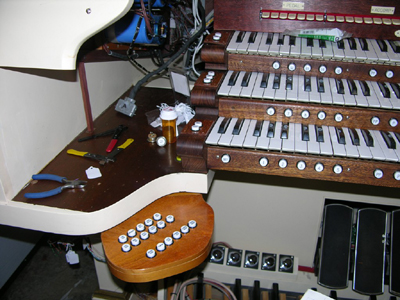


Hollywood Theatre Virtual Organ Project
|
|
 |
 |
Hollywood Theatre
Portland, Oregon
|
|
|
 |
 |
|
|
Audio system description All audio equipment is installed in a 6' high equipment rack in a room behind the stage. This includes the Echo Audiofire 12 sound interface unit that connects to the PC in the console through a firewire extender. This connection is an ordinary cat 5 LAN cable and is the only connection between the console and the audio rack . There are two separate and dedicated AC power feeds for the amplifier rack and another for the console. The speakers are placed on the stage behind
the screen, with the Main chamber speakers on the left and the Solo speakers
on the right. Each speaker in its group is spaced about 3-4 feet
apart.
Intermodulation distortion occurs to some extent on all
loudspeakers and can be heard most easily when playing major or minor thirds
on a bright reed like a Trumpet or Post Horn thru the same speaker. The
resulting sub and super tones produced are not harmonically related to either
one of the original tones. This distortion is very annoying and unmusical.
That is why the C/C# split and especially the "tone matching 2"
configuration is used, so major and minor thirds never come from the same speaker.
Further discussion of IM distortion is found here.
There is no such thing as "string channels" or
"reed channels" in this VTPO set up. That is a paradigm that
belongs to obsolete electronic organ building. Dedicating a channel or group
of channels to one rank or type of rank leads to the same inefficiency that
pipe organs have, in that most pipes are silent when playing small
combinations. If channels are dedicated to strings, as an example, they are
silent when not playing strings. All that expensive hardware just gathers dust
during that time. The current audio configuration is designed to reduce IM
distortion and spread ranks over multiple speakers systems to maximize
realism.
In addition, no string or flute unisons and celestes
originate from the same audio group. The celestes are allowed to mix
acoustically. When coming from the same speaker, celestes sound very
"electronic".
Another consideration to group assignments was to separate
the big reeds (English Horn, Trumpet, Tuba Horn) so each rank comes from a
different audio group. Same for the color reeds, etc. Example, the Main
Clarinet and Oboe Horn come from different groups. In the Solo, the Orchestral
Oboe and saxophone are separated. All the tuned percussions such as Piano, Harp and Chrysoglott all come
from different groups.
| |||||||||||||||||||||||||||||||||||||||||||||||||||||||||||||||||||||||||||||||||||||||||||||||||||||||||||||||||||||||||||||||||||||
|
A full schedule of first run movies is available. | |||||||||||||||||||||||||||||||||||||||||||||||||||||||||||||||||||||||||||||||||||||||||||||||||||||||||||||||||||||||||||||||||||||